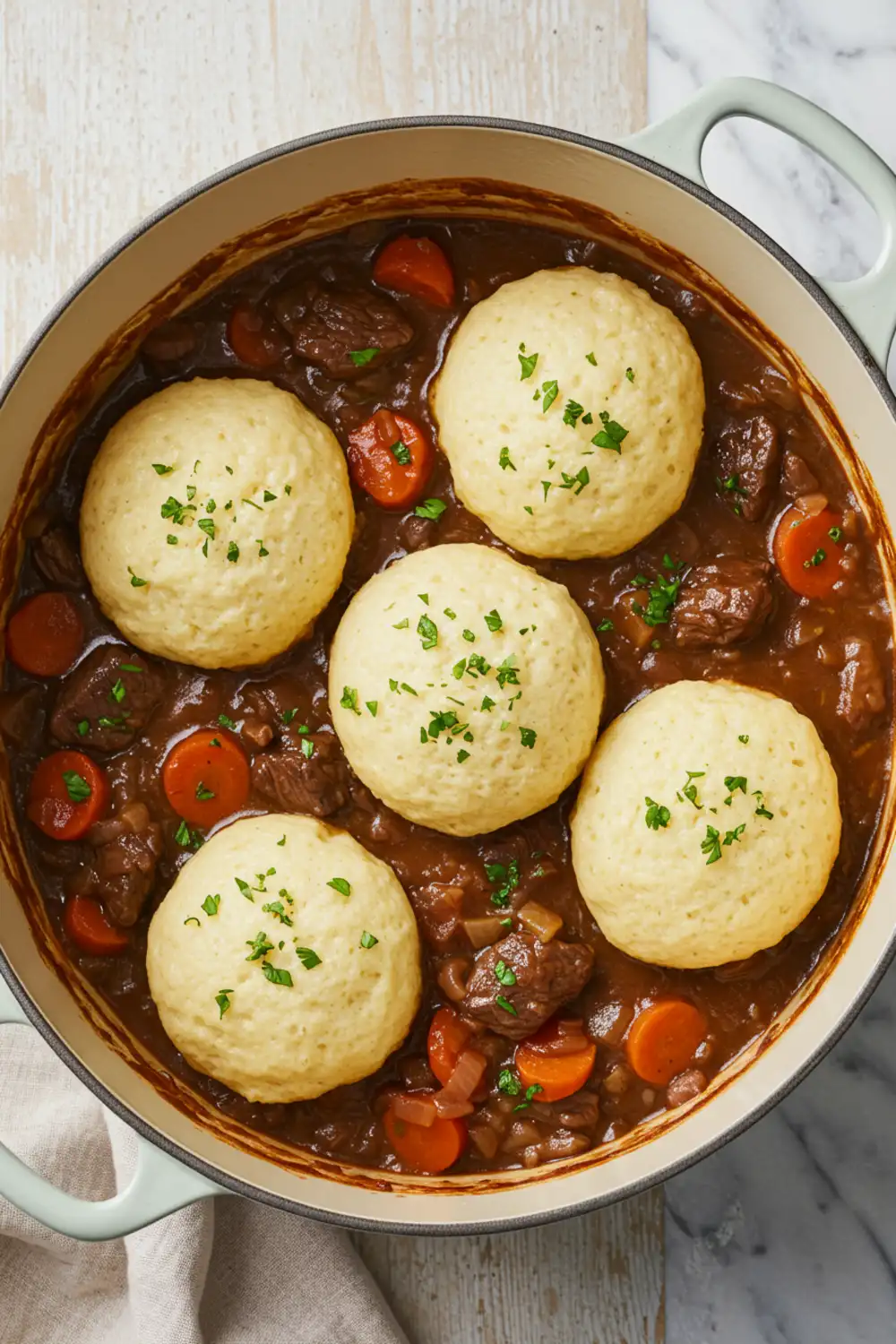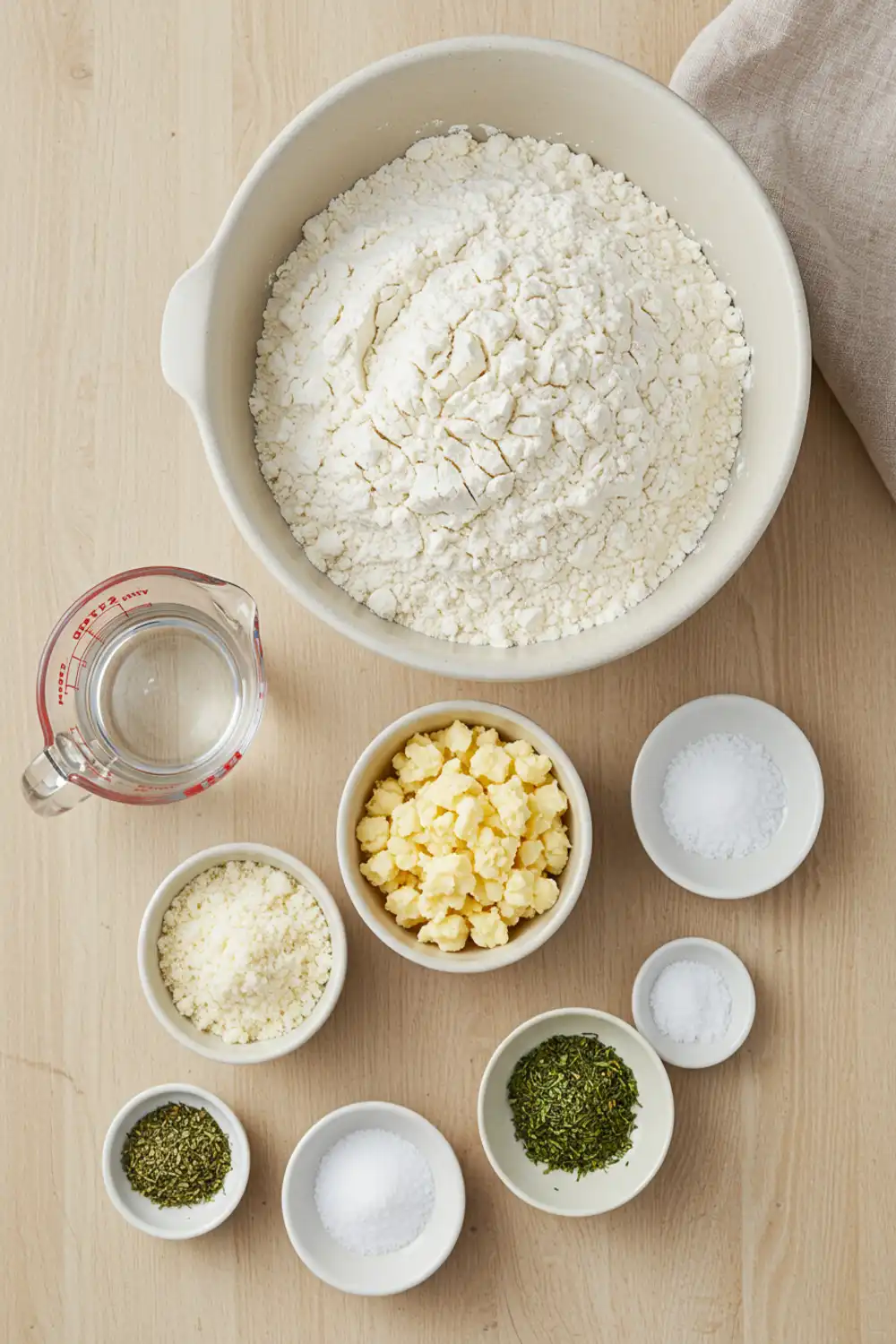Alright, gather ’round, comfort food lovers! There’s nothing quite like a steaming bowl of stew simmering away on the stove, is there? Especially when the rain is doing its thing outside here in Portland. But you know what takes a good stew from “Mmm, nice” to “Mamma Mia, that’s incredible!” status? That’s right – fluffy, melt-in-your-mouth dumplings floating on top like happy little clouds. And today, we’re talking about the easiest way to achieve dumpling perfection: using this classic Atora suet dumplings recipe.
Using Atora suet (they make veggie and beef versions!) is such a brilliant shortcut. Forget messing around with raw suet – this stuff is ready to go right out of the box, making life so much easier. My husband Mike always asks for these when I make stew – he says they remind him of something his grandma used to make (minus the terrible puns, hopefully!). So, are you ready to learn the secret to light, fluffy dumplings? Let’s get our hands doughy! This Atora suet dumplings recipe is about to become your go-to comfort food addition.
Now, don’t be intimidated by “suet dumplings.” They sound old-fashioned, but trust me, they are incredibly simple, and the result? Bellissimo! That Atora suet makes them unbelievably light and airy. So ditch any thoughts of heavy, dense sinkers – we’re making fluffy clouds today!
Ingredients for Atora Suet Dumplings
Alright, let’s gather our simple treasures! You don’t need a whole pantry clear-out for these beauties. We’re keeping it easy and delicious.
Essential Ingredients:
- 200g self-raising flour (about 1 ⅔ cups) – using self-raising makes it extra easy, the lift is built right in!
- 100g Atora suet (about ½ cup plus 1 tbsp, packed) – the star! Use veggie or beef suet, whichever you prefer or have.
- About 100ml cold water (just under ½ cup) – you might need a tiny splash more or less, we’ll eyeball it!
- A good pinch of salt (maybe ½ teaspoon) – essential for flavor!
- Optional: 1 tablespoon mixed dried herbs, or fresh herbs like chopped parsley or thyme from the garden!
Proportion Guide:
Okay, the million-dollar question I always get: “How much Atora suet for dumplings?” and “How much suet to flour?”. It’s all about the ratio, my friends! The magic number Nonna Rosa taught me for light results (even though she made gnocchi, the principle applies!) is balance. Here, it’s roughly 2 parts flour to 1 part suet by weight. So, our 200g flour gets 100g suet. Perfect! The water is where you get a feel for it – add it slowly until the dough just comes together, soft but not sloppy. Don’t worry, I’ll walk you through it! Getting these proportions right is key for this delicious Atora suet dumplings recipe.
Step-by-Step Atora Suet Dumplings Recipe
Right, aprons on! Let’s make some fluffy dumpling magic!
Mixing the Dough
First, grab a nice big bowl – room to mix! Toss in the self-raising flour and the pinch of salt. Give it a quick whisk to combine. Now, tumble in that lovely Atora suet. Use your fingertips (or a fork, if you prefer) to lightly rub the suet into the flour until it resembles coarse breadcrumbs. If you’re adding dried herbs, stir them in now. Time for the cold water! Add about half of it first, and start mixing with a knife or fork. Keep adding the water, just a little splash at a time, mixing until a soft, slightly sticky dough forms. You want it to come together but not be overly wet or dry. If it feels too dry, add a tiny drop more water; too sticky, a tiny dusting more flour. Be gentle!
Getting the feel for dough is part of the fun! This simple mixing is the heart of our Atora suet dumplings recipe.
Shaping Dumplings
Next up, shaping! Lightly flour your hands – this stops the dough from becoming one with your palms! Scoop out spoonfuls of the dough (a regular spoon size is good). Gently roll the dough between your palms to form little balls, about the size of a golf ball or maybe a ping pong ball. Don’t pack them tightly or roll them too much – just enough to shape them. Overworking makes them tough! Place your cute little dumplings on a lightly floured plate while you make the rest.
Cooking Methods
Now for the cooking! You’ve got options, amici, depending on your preference and what you’re serving them with:
- Classic Stew-Top Simmer: This is my favorite way for maximum flavor absorption! Carefully place the dumplings on top of your gently simmering stew or soup (make sure there’s enough liquid!). Pop the lid on tightly and let them steam away for about 20 minutes. No peeking for the first 15! They’ll puff up like magic. This works beautifully with something like a traditionalLamb Hotpot Recipe.
- Oven Baked Option: Want a slightly firmer dumpling with a golden top? You can bake them! Place the dumplings on a lightly greased baking sheet. Bake at 400°F (200°C / 180°C Fan / Gas Mark 6) for about 20-25 minutes, until puffed and golden. These won’t be quite as soft as the steamed ones.
- Slow Cooker Simplicity: Making stew in the slow cooker? Perfetto! Just gently place the raw dumplings on top of the hot stew about 1-2 hours before it’s done (1 hour on high, maybe 1.5-2 hours on low). Make sure the lid is on tight! Check one dumpling to ensure it’s cooked through before serving.
Need more visuals on making traditional dumplings? This resource from Easy Peasy Foodie has some great step-by-step photos!
Tips for Perfect Dumplings
Okay, let’s make sure your dumplings are perfetto every single time!
Are Dumplings Better in the Oven or Slow Cooker?
Ah, the big debate! Honestly? It just depends on the texture you want! Boiling/steaming them on top of the stew gives you that classic, soft, fluffy dumpling that soaks up all the yummy gravy – pure comfort! Baking gives them a slightly firmer texture, maybe even a little crisp on top. Slow cooker dumplings get super soft and tender from that long, gentle steam. So, think about what you prefer! I love the super soft stew-top ones best, but sometimes a baked one is nice for a change. Both ways work great with this Atora suet dumplings recipe!
Common Mistakes and Fixes
- Why are my Atora dumplings hard? Mamma mia, nobody wants a dumpling cannonball! Usually, hard dumplings mean the dough was mixed too much (be gentle!), maybe a bit too much water made it heavy, or they weren’t cooked quite long enough to puff up. Make sure your stew is simmering nicely when you add them so they get good steam. If they seem dry while cooking, add a little more hot liquid to the stew pot. We’ve all had kitchen oopsies – don’t stress, just try again! Knowing these little fixes helps you master the Atora suet dumplings recipe.
Flavor Enhancements
Have fun with it! Add a little grated Parmesan or cheddar cheese to the dough – cheesy dumplings are amazing! A pinch of garlic powder or onion powder? Delish! Fresh herbs are wonderful – finely chopped parsley, chives, thyme, or rosemary stirred into the flour add so much flavor. I sometimes add smoked paprika for warmth. Make this Atora suet dumplings recipe your own!
Pairing Dumplings with Dishes
These fluffy dumplings are the best friends of hearty, savory dishes!
Classic Stews and Soups
Think classic pairings! Beef stew, chicken and vegetable casserole, Irish stew, a thick lentil soup… dumplings are born for these rich, comforting dishes. They soak up that gravy like little sponges of joy!
Modern Takes
But don’t stop there! Try them floating on a creamy mushroom soup. Or serve them alongside pulled pork instead of a bun. Drop them onto a veggie chili or even a mild curry for a fun textural twist. Why not? Cooking is an adventure!
Storage and Reheating Tips
Keeping Dumplings Fresh
- Uncooked Dough/Dumplings: You can make the dough, shape the dumplings, and keep them covered in the fridge for a few hours before cooking. You can also freeze the raw, shaped dumplings! Place them on a parchment-lined tray, freeze until solid, then transfer to a freezer bag. Cook them straight from frozen, just add a few extra minutes to the cooking time.
- Cooked Dumplings: Got leftovers? Lucky you! Store cooked dumplings (ideally separate from the stew, if possible, to prevent sogginess) in an airtight container in the fridge. They’re best eaten within a day or two.
Reheating for Softness
- The absolute best way to reheat cooked dumplings is to gently steam them again. You can place them back on top of simmering stew or soup for 5-10 minutes, or steam them in a steamer basket over boiling water. Microwaving can sometimes make them a bit tough, so steam if you can!
Nutritional Information
Let’s quickly touch on the nutrition side of things. Comfort food isn’t always “health food,” but everything in moderation, right?
Calorie Count of Dumplings
Okay, honesty time! A dumpling made with this Atora suet dumplings recipe will probably land somewhere around 150-200 calories, depending on its exact size and if you added cheese or other extras. Good to know!
Healthier Alternatives
Want to lighten them up just a touch?
- Light Suet: Atora makes a ‘Light’ vegetable suet version which has less fat. Look for that if you want to cut down a bit.
- Flour Power: You could try swapping some (maybe 1/4 or 1/3) of the self-raising flour for whole wheat flour to add a bit more fiber. Just be aware the texture might be slightly denser. The 2:1 flour-to-suet ratio still applies! These little tweaks can help tailor the Atora suet dumplings recipe to fit your preferences.
Atora Suet Dumplings: Recipe
Ingredients
Method
- Mix Dry Ingredients: In a large bowl, combine the self-raising flour and salt.
- Add Suet: Add the Atora suet to the bowl and mix until the mixture resembles breadcrumbs.
- Add Water: Gradually add cold water, mixing until a soft, sticky dough forms. Adjust water as needed – add more if too dry, a bit more flour if too wet.
- Add Herbs (Optional): If using, stir in the mixed herbs.
- Shape Dumplings: Lightly flour your hands. Take a spoonful of dough and gently roll it into a ball about the size of a golf ball. Don’t overwork the dough. Place the shaped dumplings on a lightly floured plate or tray.
- Boiling: Place dumplings on top of a simmering stew or soup. Cover the pot and steam for about 20 minutes.
- Oven-Baking: Place dumplings on a baking tray and bake at 200°C (180°C fan/ Gas Mark 6) for 20-25 minutes, until golden brown.
- Slow Cooker: Place the dumplings on top of your stew in the slow cooker, cover and cook on high for an hour or low for two. Check they are cooked through before serving.
- Serve: Serve the cooked dumplings with your stew, soup, or chosen pairing.
Notes
- The key ratio is roughly 2:1 flour to suet (e.g., 200g flour to 100g suet).
- Add water gradually until a soft, sticky dough is formed.
- Don’t overmix the dough.
- Lightly flour hands to prevent sticking.
- Cooking time will vary depending on the method.
- Adjust flavors by adding cheese, garlic powder, fresh herbs, or smoked paprika.
- Uncooked dumplings can be stored in the fridge for a few hours or frozen for later use.
- Cooked dumplings are best eaten within 2 days.
- To reheat cooked dumplings, steam them over simmering water or add them back to your stew.
FAQs
How much Atora Suet for dumplings?
A: Okay, let’s get this straight! The golden rule is to keep the ratio at roughly 2:1, flour to suet. Specifically, this usually means that for every 200g of self-raising flour, you want to use about 100g of Atora suet. This ratio ensures your dumplings are lovely and light. Think of it as the secret to success for any Atora suet dumplings recipe! >Indeed>, this precise measurement is very important. check more in this article.
Q: How much Atora Suet for dumplings?
A: Okay, let’s get this straight! The golden rule is to keep the ratio at roughly 2:1, flour to suet. Specifically, this usually means that for every 200g of self-raising flour, you want to use about 100g of Atora suet. This ratio ensures your dumplings are lovely and light. Think of it as the secret to success for any Atora suet dumplings recipe! Indeed, this precise measurement is very important. check more in this article.
Q: How much suet to flour?
A: >Again,> the magical ratio is roughly 2:1! You can think of it as 2 parts of flour for every 1 part of suet. It doesn’t have to be absolutely exact, but getting it close will mean beautifully fluffy dumplings every single time. If you add too much suet, your dumplings can become a bit heavy, so it’s always best to measure it out. >Therefore,> sticking to this ratio is key for your Atora suet dumplings recipe. for more details.
Q: Are dumplings better in the oven or slow cooker?
A: Ah, the age-old question! It really depends on what you’re after. >For instance,> oven-baked dumplings get a slightly crispy bottom, which gives you a bit of a different texture. Slow cooker dumplings are more about a super soft texture, soaking up all the lovely flavors, because they cook in all the lovely juices. I often do both depending on my mood! Nevertheless, both methods offer a great way to cook your Atora suet dumplings recipe. see more in this article.
Q: Why are my Atora dumplings hard?
A: Oh no, hard dumplings are the worst! Usually, this happens when the dough has been overworked, or you’ve added too much water or perhaps not enough. Another reason is not cooking them long enough. Also, sometimes they can turn hard if you add them too early in the cooking process. If you’re boiling them, aim to drop the dumplings in during the last 20 minutes of your dish’s cooking time. This gives them enough time to cook through and keeps them light! If you do make hard dumplings, try adding a dash more liquid to the pot when cooking and steaming them to see if that helps to soften them. Ultimately, with a little practice, you’ll conquer any challenges with this Atora suet dumplings recipe! here’ the full article.
Now you’re officially armed and ready to create the fluffiest, most comforting Atora suet dumplings recipe ever! Get ready to wow your family (even the picky eaters like my Luca might surprise you!) with this classic comfort food addition. Want to try the traditional beef suet version? Check out this Atora Beef Suet Dumplings Recipe and get cooking!
Happy dumpling making, everyone! Remember, cooking should be fun, and life’s definitely too short for bad dumplings! Now, if you’ll excuse me, I think I smell a stew starting to simmer… time for dumplings, of course! Buon appetito!



Bellissimo!